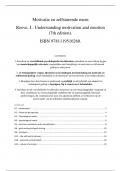Samenvatting
Samenvatting Understanding motivation and emotions
- Instelling
- Universiteit Utrecht (UU)
Dit is een samenvatting van het boek van Reeve, Understanding motivation and emotions. Het betreft een samenvatting van alle hoofdstukken (1 t/m 12, exclusief 3 en 7) die getoetst worden op het tentamen van Motivatie en de Zelfsturende mens.
[Meer zien]





